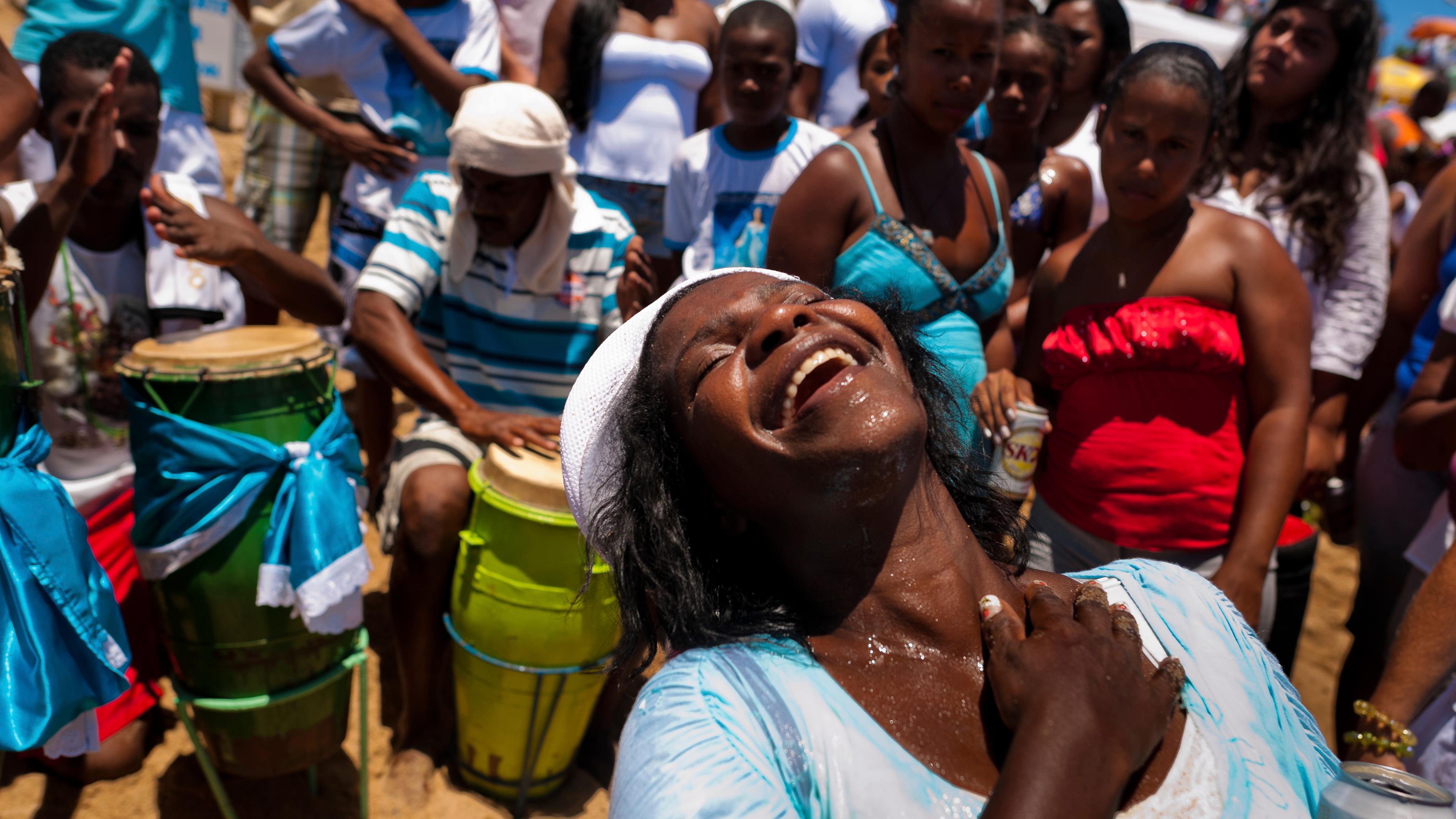When a person takes ketamine, time can slow down. Their perception of their body might start to shift: limbs expand to be bigger, shrink smaller, or their physical form feels very far away. Noises distort, and they might see the world through a tunnel. The walls move slowly in and out, like a breathing chest.
Ketamine has been approved by the US Food and Drug Administration (FDA) as an anaesthetic drug since 1970, and it’s currently being researched for the treatment of several mental health conditions, such as depression. The FDA approved a ketamine derivative called esketamine for treatment-resistant depression in 2019. When taken at lower, subanaesthetic doses, ketamine is often called a ‘dissociative’ because it makes people feel out of touch with their bodies or environments.
As ketamine has taken on a new role as a treatment for depression, the accompanying feeling of dissociation has often been characterised as an undesirable side-effect of treatment, says David Mathai, a psychiatrist in private practice in Miami who trained at the Johns Hopkins Center for Psychedelics and Consciousness Research.
When Mathai first started working with ketamine-assisted therapy for depression, he says he was taught to see it as a treatment with rapid antidepressant effects because of how the drug interacted with brain receptors, not from the experiences the drug induced. But as Mathai observed more sessions, he began to wonder if researchers should be paying closer attention to the dissociation. ‘The more I started seeing patients’ experiences at different clinics, in different settings, the more it felt like we were missing this really big part of what ketamine did: the subjective, dissociative effects,’ he says.
Generally speaking, clinicians talk about dissociation negatively. When people are continually disconnected from themselves and their surroundings, they can even be diagnosed with a dissociative disorder. A sense of detachment from the world around you, your memories, or physical sensations can be unnerving and alienating, and it’s associated with states such as anxiety, stress and trauma. People’s experiences on ketamine offer another, more provocative way to regard this state: there might be qualities of dissociation – those same feelings of disengagement with the self or body – that people enjoy or find value in. That feeling could be an important ingredient in why ketamine-assisted therapy helps with depression symptoms. There are more mild versions of pleasurable dissociative states that we all encounter on a daily basis in other contexts: flow states, sex, or getting lost in a good book or movie. In some cultures, people experience even extreme dissociation in positive ways.
‘We might think of dissociation on a broader spectrum, where it’s not necessarily pathological,’ Mathai says. ‘There may be more normative, even adaptive, ways of thinking about dissociation.’ If we regard dissociation as only a troubling side-effect, people may be unprepared to interpret the dissociation they feel while taking ketamine, and so lose potentially beneficial aspects of the dissociative experience. Or, in the growing cases of ketamine addiction, they might be surprised by how appealing they find it to be.
If I ask a friend how they are feeling and they reply ‘I’m so dissociated,’ I would probably be concerned. I might follow up by asking what’s wrong, or assume they’re tired, sad or overwhelmed. In American psychiatry’s diagnostic system (the Diagnostic and Statistical Manual of Mental Disorders or DSM), dissociation is described as a disruption of cognitive functions that are typically integrated: memory, perceptual and sensory awareness, information-processing. Yet dissociation has a longer history that predates the current iteration of the DSM.
One of the earliest conceptions of dissociation comes from the French psychologist Pierre Janet. In the 1880s, he wrote about cases of ‘double consciousness’ when people underwent hypnosis, had hysteria, or participated in spirit possession or mediumship. In these states, they weren’t able to integrate their ‘ideas and functions that constitute personality’. If someone had a trauma early in life, Janet suggested, trauma would interfere with their process of having a more integrated sense of self – a dissociated structure of mind.
This, in part, led to how, in modern psychiatry, the term dissociation tends to describe dissociative disorders and severe trauma – all pathologically dissociative states. Still, even Janet saw that some people liked the feeling of dissociation. He described people who started to intensely crave the dissociated feeling from being hypnotised; he called it ‘la passion somnambulique’.
The feeling of dissociation itself often isn’t distressing all on its own
We can look to other cultures to see how there can be more alternative interpretations of dissociative states. Rebecca Seligman, a medical anthropologist at Northwestern University in Illinois, began to be interested in dissociation through research on mediumship and spirit possession specifically in Brazil. In the Candomblé religion, dissociative experiences are thought of as part of spiritual life. With these cultural structures in place, when people feel dissociated, it’s expected or appropriate. People interpret dissociation as a disturbance by spirits called orixás, including a discontinuity of self, disconnection from the body, memory, responsibility and personal identity. Dissociation is seen as a person being in communion with the gods, and that their own consciousness is displaced by that of a powerful other being.
‘They have what we would think of as dissociative experiences, but ones that are very positively valued and experienced in very positive ways,’ Seligman says.
In 2006, Lisa Butler, a philosopher and psychologist at the University of Buffalo in New York, argued that most dissociative experiences are, in fact, not pathological. Many altered states, such as meditation or religious trances, involve dissociation. Also: daydreaming, fantasy and absorption. When I go to a hot yoga class, scroll TikTok, pick up a new book or start a Netflix show then, according to Butler, I am choosing to dissociate because I’m taking a minibreak from my thoughts or body. Butler considered non-pathological dissociative states to be any departure from an integrated bodily or sensory experience. This could include getting lost in a novel, watching an engrossing movie, having sex, or flow states, as described by the psychologist Mihaly Csikszentmihalyi: ‘a state in which people are so involved in an activity that nothing else seems to matter.’
I enjoy tapping into flow states – becoming so engrossed in researching a new topic, or weeding in my community garden – that I lose sense of time, my body and my identity for a short while. Butler wrote that we seek out non-pathological dissociative experiences because they are pleasurable, and they take us out of our everyday selves. There are many more mundane episodes of dissociation we all experience regularly, such as ‘highway hypnosis’, when people drive on their usual commutes, and then realise later they don’t remember most or any of their journey. All these everyday instances of dissociation are, of course, fleeting, and we can usually snap out of them whenever we choose; we have a sense of control over them. But what they show is that the feeling of dissociation itself often isn’t distressing all on its own. Dissociation happens to all of us on a continuum, and is ‘maybe a value-neutral mechanism that we all have,’ Seligman says.
In clinical trials of ketamine for depression, dissociation usually ends when the drug experience ends, leading it to be regarded as an adverse event and a common, unwanted side-effect. When the telemedicine ketamine company Mindbloom asked if people felt disconnected from their bodies while taking ketamine, nearly 90 per cent of patients said they did.
Before taking ketamine with his psychiatrist, the writer Steven Petrow read in his consent forms that the possible side-effects might include a ‘loss of sense of self’ or ‘changes in the perception of time’. ‘In looking back I realise I didn’t fully appreciate what all that meant,’ Petrow wrote in an essay about his experience in The Washington Post in 2023. During each session, he couldn’t locate his body in space, or his doctor. ‘I experienced disequilibrium,’ he wrote. ‘Imbalance. Unable to find my place. Somewhere between scary and terrified.’
In contemporary studies, dissociation is often described to people as an adverse event
Other drug-assisted therapies, such as therapy combined with taking psilocybin (the ingredient from magic mushrooms), have placed a strong emphasis on the importance of subjective effects induced by the drugs, such as mystical experiences or strong feelings of connectedness. By contrast, with ketamine, the benefits have been argued to reside in its neuropharmacological effects. John Krystal, a professor at Yale University in Connecticut and one of the first ketamine-for-depression researchers, says that, generally speaking, he doesn’t consider there to be a relationship between outcomes of treatment and the amount of dissociation a person experiences. When people are given antidepressant doses, it usually also produces dissociative symptoms at the same time, but he doesn’t think that means they are related.
‘I am not aware of any therapeutic effect arising directly from dissociation produced by ketamine,’ Krystal says.
A handful of reviews have found mixed evidence on this question. In one review paper by Mathai and colleagues, three of eight studies, and 55 per cent of the total sample, showed a significant correlation between subjective effects and antidepressant effects for ketamine – meaning that more dissociation was associated with more benefit – but not necessarily what caused it. When researchers from Johnson & Johnson, the pharmaceutical company that produces Spravato, the FDA-approved esketamine for depression, looked at phase-3 clinical trial data in 2022, they found no effect of dissociation on antidepressant effects. It’s worth remembering though, as Mathai and his co-authors have noted, that in contemporary studies, dissociation is often described to people as an adverse event. ‘Most studies of ketamine have also not examined the relevance of dissociation in the context of psychotherapy,’ they wrote.
When we consider how dissociation can feel enjoyable in other contexts, there’s a shorter distance to travel to understand how the experience of ketamine might offer a timeout from the ordinary state of mind. Garrett Deckel, the late assistant clinical professor of psychiatry at the Icahn School of Medicine at Mount Sinai in New York, provided ketamine-assisted therapy; people had told her dissociation was helpful because it put distance between them and their feelings. ‘What my patients tell me is that one way that ketamine is helpful is because there is a buffer that it provides,’ Deckel told me. ‘Precisely because it does disconnect them somewhat from their feelings, they’re able to approach their feelings.’ If someone has recurring negative thoughts about not being good enough, or that life doesn’t matter, those thoughts become less important, less foregrounded in the dissociative state.
There’s been scant qualitative work that actually asks people about what they feel when they take ketamine. Joost Breeksema, executive director of the OPEN Foundation in the Netherlands and a psychiatry researcher, interviewed people after they did a six-week, twice-weekly esketamine treatment programme for treatment-resistant depression. Breeksema says they were regularly told that their subjective effects should be ignored. As a result, ‘the people that I interviewed said they were ill-prepared for the subjective effects of ketamine,’ he says.
In Breeksema’s conversations, there was variety in how people interpreted their dissociation. Many people detached from their bodies, some in ways that weren’t negative. ‘It was like floating out of your body, going up and outside of my body, floating around freely without space and time. Lovely,’ said one patient. Another said: ‘My [self] is just gone. These were really experiences outside of myself.’
‘They no longer associate themselves as much with their everyday or deeper issues,’ Breeksema says. ‘They become more detached from their emotions, especially incessant, negative emotions.’ Some didn’t enjoy it at all, feeling dizzy or disoriented. Some, like Petrow, felt frightened.
When people unwillingly leave their usual state of consciousness, it can be unnerving
Recognising that people may enjoy, seek out or derive therapeutic pleasure from dissociative states is also crucial to appreciating ketamine’s addictive potential. People can build a physical tolerance to ketamine, needing higher doses to arrive at the same sensations – but they can also become psychologically dependent on the feeling of dissociation. For her article on ketamine’s addictive potential for Business Insider in 2023 , the journalist Anna Silman spoke to a woman named Nadia, a physician in New York, who developed a dependence on ketamine, doing it daily and at home alone.
‘Nadia was particularly drawn to the feeling of the k-hole, the dissociative high that comes from taking a large dose of ketamine,’ Silman wrote. ‘It’s like the fourth dimension that nobody can see but everybody knows is there,’ Nadia told Silman. ‘It feels like an escape where you’re totally at peace.’
Gaining a broader understanding of dissociation through a drug like ketamine doesn’t mean concluding that dissociation is all good, or all bad – just that it is powerful and warrants attention. Seligman cautions that cultural containers are powerful. It may be difficult for extreme dissociation to be experienced positively by everyone, because of ideas about how the ‘self’ is supposed to feel. In Euro-American contexts, the self is thought of as autonomous, integrated, unitary and coherent. When people unwillingly leave their usual state of consciousness, without choosing to do so, and experience a self that isn’t as coherent as it’s ‘supposed’ to be, it can be unnerving. ‘We live in a context in which more intense dissociative experiences have been framed as negative for a really long time,’ Seligman says.
But as ketamine clinics continue to open around the United States, Mathai wonders if there isn’t a missed opportunity to prepare people for dissociation in a way that could provide deeper psychological benefit, and offer warning for those who might enjoy this state too much. While some people could be helped or frightened by the dissociation in therapy, others are inexorably drawn to it.
‘It does allow people to escape from the oppressiveness of the “I”,’ says Seligman.








